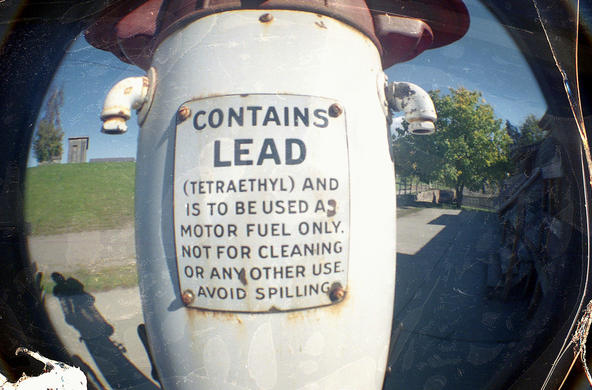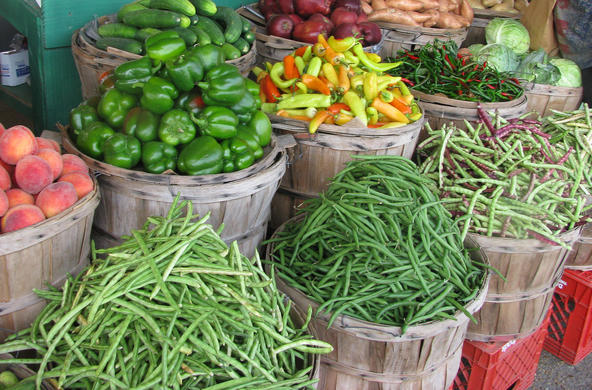Pastoral scenes are fine for artwork, but by no means is modern agriculture a “green” endeavor. Food production is responsible for about 1/3 of our greenhouse gas emissions, about 80 percent of the emissions of reactive nitrogen, and huge amounts of pesticides in the environment. In a very real sense, we’ve substituted services that nature provides for free—such as the recycling of nitrogen from decomposing plant remains—with exogenous inputs, like nitrogen fertilizers. Pesticides are applied without regard to the natural predators of insects, including other insects and birds that might do the job for us.
Modern agricultural is based on planting a crop in monoculture, with an eye solely on yield and profits. These are grain factories. Often the plants are genetically identical, even genetically engineered, to maximize yield and to resist herbicides that are applied to keep the fields weed-free. The diversity of soil bacteria and fungi is sacrificed and replaced with fertilizer. Planting to the edges of fields eliminates adjacent habitat that would harbor birds and other predators of insects.
Since the end of World War II, pesticide use in agriculture has skyrocketed, despite the warnings by Rachel Carson in The Silent Spring of toxicity and inadvertent exposures. While the growth in pesticide use has slowed in the United States—to 230,000 metric tons per year, the newest pesticides show a 4 to 48-fold increase in toxicity from contact and oral exposure, compared to those used just a few years ago. In many cases, neonicotinoid-based pesticides are selected, despite their known toxicity to bees and other insects that are essential for crop production.
There is increasing evidence that exposure to neonicotinoid pesticides extends well beyond the borders of agricultural fields. The inadvertent drift of agricultural chemicals, especially insecticides and herbicides, is linked to the widespread decline of insects in natural ecosystems. Studies of insects in 150 grasslands in Germany showed losses of 67% of biomass, 78% of abundance, and 34% of insect diversity, with the only significant correlate being proximity to agricultural land. Similar results were seen in an analysis of 30 forested sites.
In organic agriculture, soils and plants are explicitly expected to be pesticide-free. But, in one recent survey in Switzerland, neonicotinoids were found in 93% of organic soils and crops, presumably due to drift from neighboring fields.
Exposure and impacts of neonicotinoids on birds feeding in agricultural fields lowers their physiological function. Runoff of neonicotinoids applied to farm fields in Japan led to a decline of zooplankton and fishes in nearby lakes. Pursuit of insect-free farming is resulting in a loss of diversity at higher trophic levels across the landscape.
Of course, the alarming aspect of all this is how little we know of the long-term impact of pesticide exposure to humans. Casting precaution to the wind, many of these chemicals were adopted without evidence that they were safe—only that they did not show acute toxicity to humans. We need a whole-sale rethinking of the regulation of agricultural chemicals to ensure safety before they are in widespread use. They may produce a bounty of food, but in the long-term, factory-farm monocultures are not good for us or for the other species that share the planet with us.
References
Bernhardt, E.S., E.J. Rosi and M.O. Gessner. 2017. Synthetic chemicals as agents of global change. Frontiers of Ecology and the Environment 15: 84–90, doi:10.1002/fee.1450
DiBartolomeis, M., S. Kegley, P. Mineau, R. Radford, and K. Klein. 2019. As assessment of acute insecticide toxicity loading (AITL) of chemical pesticides used on agricultural land in the United States. PLoS One doi: 10.1371/journal.pone.0220029
Eng, M.L., B.J.M. Stutchbury, and C.A. Morrissey. 2019. A neonicotinoid insecticide reduces fueling and delays migration in songbirds. Science 365: 1177-1180.
Humann-Guilleminot, L.J. Binkowski, L. Jenni, G. Hilke, G. Glauser, and F. Helfenstein. 2019. A nation-wide survey of neonicotinoid insecticides in agricultural land with implications for agri-environment schemes. Journal of Applied Ecology doi: 10.1111/1365-2664.13392
Jach-Smith, L.C. and R.D. Jackson. 2019. Inorganic N addition replaces N supplied to switchgrass (Panicum virgatum) by arbuscular mycorrhizal fungi. Ecological Applications doi.org/10.1002/eap.2047.
Seibold, S. and 18 others. 2019. Arthropod decline in grasslands and forests is associated with landscape-level drivers. Nature 574: 671-674.
Yamamuro, M. and 5 others. 2019. Neonicotinoids disrupt aquatic food webs and decrease fishery yields. Science 366: 620-623.






